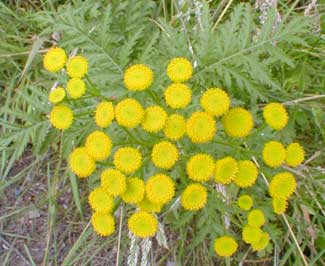
Common Tansy; or,
Stinking Willie
"Like the bee that now is blown
Honey-heavy on my hand,
From his toppling tansy-throne
In the green tempestuous land."
-Edmund Blunden
(1896-1974)
(1896-1974)
Common tansy is also known as Golden Buttons for the tiny chrysantheum-like flowers; Bitter Buttons or Ginger Plant because the flowers taste of ginger, or worse; Cow Bitter because the flavor of milk is spoilt if the cow forages tansy; & mugwort because it shares several presumed medicinal values with artemisia also called mugwort.
The name Stinking Willie shared with Tansy Ragwort (Senecio jacobaea) is to the honor (or dishonor) of William Augustus, Duke of Cumberland, who means of relentless butchery suppressed the Jacobite Rebellion in 1745. Transy's odor lent it the additional name Scented Fern, while for its scent & flower color it was called Cheese.
By the 15h Century, tansy was eaten on Lent in imitation of the bitter herbs eaten in Jewish households on Passover, for remembrance of hardships in the wilderness. William Turner in A New Herball (1551-1568) attempted a non-religious reason for tansy being eaten with the Lent meal, claimit it was to control flatulance resulting from the fish & beans of the Lent meal. Poet Elsie Cole (1884-1968) was probably closer to the truth when she wrote of tansy as a protection against misfortunes:
"Mix tansy in your Easter cake & earn a placid year,This folk-tradition likely has a pagan origin that was coopted in Easter, Lent, or Passover ritual. To the ancient Greeks tansy was known as Ganymede, because it was the herb that had been given to Ganymede, the beautiful young boy lover of Zeus, to preserve his youth eternally. Ganymede was something of a savior divinity, dying & reborn seasonally, so that his myth was easy transferred to Jesus as a new Ganymede.
For though you cross the Little Folk they cannot then offend."
Since tansy was used for centuries in custards & quiches, it's hard to believe it is at all dangerous used in moderation as a dried or cooked spice, but it has definitely fallen from favor among herbalists because not always safely used, containing as it does toxic thujone. If well-cooked, the thujone breaks down & the plant is safely eaten.
It was once regarded as effective in treating intestinal worms, or externally for fleas or lice, & was a midwife "cure" for pregnancy since a sufficient dose can induce miscarriage, which would today be an indicator of its dangers. Yellow dye can be obtained from the buttons, & green dye from the shoots. The active chemical ingredients include camphor, borneol & thujone which function as an insect repellant, though even so butterflies & bees love the little yellow button blossoms.
Native to Europe, it was brought to Colonial America by early settlers who valued it for medicinal uses. it quickly escaped into the environment where it had few insect enemies. In Europe many insects were adapted to feed & reproduce on tansy, but in North America its spread was resistant to all pests, which facilitated its spread. This feature has been used constructively, as in field tests tansy was interplanted with potatoes & discovered to protect the crop from the Colorado potato beetle.
A common roadside weed here on the Kitsap Peninsula, as elswhere in the Pacific Northwest, it's arrival in the west & northwest is surprisingly recent. Between the 1600s to the early 1800s tansy colonized the entire west coast of north america, then began its slow march westward. it was documented in kansas in 1912, montana in 1936, & was widespread on the pacific coast by 1952. it is now found just about everywhere, in regions of high or low rainfall, in poor soils & good soils, with a preference for very hot sunny locations but also quite cold-hardy.
Noxious weed researchers Ron LeCain & Roger Sheley in an article about common tansy for the Montana State University Extension wrote, "In 1668, the first president of Harvard University was buried wearing a common tansy wreath in a common tansy lined coffin. When Harvard's cemetery was relocated in 1846, the common tansy in this coffin still held its shape & fragrance." The importance of tansies in funeral customs is discussed in the separate article on Curly Tansy T. vulgare var crispum), but it is worth repeating here that the name Tanecetum refers to Thanatos, which is Death, or the land of the dead.